
It’s time for Apple’s lightning port to die. You know it, I know it, and Apple knows it.
Nobody likes change, even though change is a fundamental, almost DNA-level part of technology and innovation. However, a decade after Apple unveiled the lighting port and associated cables with the iPhone 5, we’re ready for a more universally accepted port and plug.
The lightning port is now a decade old and its introduction on September 12, 2012, was met with a similar concern. You see, the tiny 8-pin connector was elbowing aside Apple’s much wider (and widely-used) 30-pin connector that predated the introduction of the iPhone.
An entire industry was built around that connector. If you owned an iPod of any generation right up to the iPod touch 5th Generation, you probably also had a dock, possibly from Griffin (opens in new tab), that connected to big speakers. It was not uncommon to walk into someone’s house and pop your iPod or iPhone into their speaker dock to fill a party with the prog-rock sounds of your personal playlist.
End of another port era
News of Apple discontinuing the 30-pin connector was met with alarm. We all owned multiple 30-pin charging cables and accessories.
When the iPhone 5 shipped in 2012, Apple did its best to assuage concerns by offering a free 30-pin connector-to-lighting port plug adapter. I still have a few in my drawer.
Accessory manufacturers were a little less panicked than users. They were still selling speakers, docks, third-party charging cables, and adapters to millions of legacy iPhone, iPad, and iPod owners.
Perhaps being more prescient than others. Logitech told WiredUK (opens in new tab) at the time, “You can still find Logitech speaker dock products in retail that work with older Apple devices, but we’re getting ready for a wireless Christmas.” In other words, Logitech foresaw the rapid rise of Bluetooth and Wi-Fi-enabled audio. Wireless charging, however, was still not a thing.
A necessary change
Apple’s reasoning for dropping the 30-pin connector was obvious back then. First, a plug with no moving parts would be cheaper and easier to manufacture. Also, the company was making more powerful devices and needed to cut down the number of charge-and connectivity-related components to make room for, for instance, larger batteries and other more useful components (better and more powerful A-series chips, more sensitive and sophisticated haptics, and far more powerful, larger, and high-resolution screens). Maybe Apple just wanted to make space for the NFC contactless payment technology.
If and when Apple does kill the lightning port, though, the reasons will not entirely revolve around technology considerations.
As I write this, the European Union is pressuring Apple to stop using its proprietary charging system, which requires the proprietary lighting cable. This is not because the EU prefers USB-C, but because doing so would potentially cut down on E-Waste. While the EU’s measure is not binding and Apple “expressed concern,” I suspect Apple will fall into line within one or two iPhone update cycles. Rumors now point to a USB-C port not on the iPhone 14, but maybe for the iPhone 15.
I do think it’s possible that Apple could surprise us and introduce the USB-C port on one iPhone 14 model, maybe the iPhone 14 Pro Max.
Whatever Apple does, though, our world will not come crashing down around us because Apple discontinued the lighting port.
We’ll survive
First of all, we survived Apple sunsetting the 30-pin connector. I recall there being something approaching panic before, during, and directly after the iPhone 5 launch, but it subsided quickly. We had our old cables if we still wanted to use them with old devices, but our new ones shipped with new cables (and adapters – those were the days). Plus, the iPhone 5 sold out within days (opens in new tab) of launch. I guess we all decided back then we could live with the change.
In short order, we had just as many excess lighting cables as we once did 30-pin connector ones. Soon, we were discovering that while these cables were lighter and easier to carry, they were no less prone to wear and tear than the previous cables. Have you ever seen a lighting port cable “turtle neck (opens in new tab)”? You know, when the cable sheath starts to break down and bunch up right before the business end of the cable? Or maybe you’ve seen the collar that sits right behind the 8-pin plug crack.
Right, these plugs are not some precious things we need to cherish and protect.
The lighting cable and port (oh, yes, the port that often gets so stuffed with dust and debris that you can no longer charge your phone without first digging out the muck) have had their time.
What Logitech presaged back in 2012, the wireless future has come to pass not just for audio, backup, and data transfers. Current (iPhone 13) and future iPhones will feature wireless charging, MagSafe-style. Maybe we should be asking ourselves if future iPhones even need a port. Apple is clearly already asking that question.
When Apple does introduce its first USB-C iPhone, followed by the iPad, you should welcome the change. Not only will the port open up some new fast-charging capabilities, but you will notice that the cables you have for any number of other gadgets produced within the last five years now also work with your new iPhone.
This is a win, so get over it.
Be the first to comment